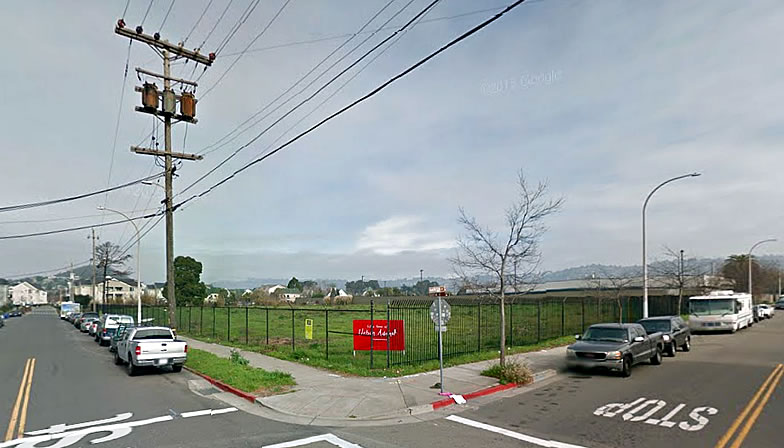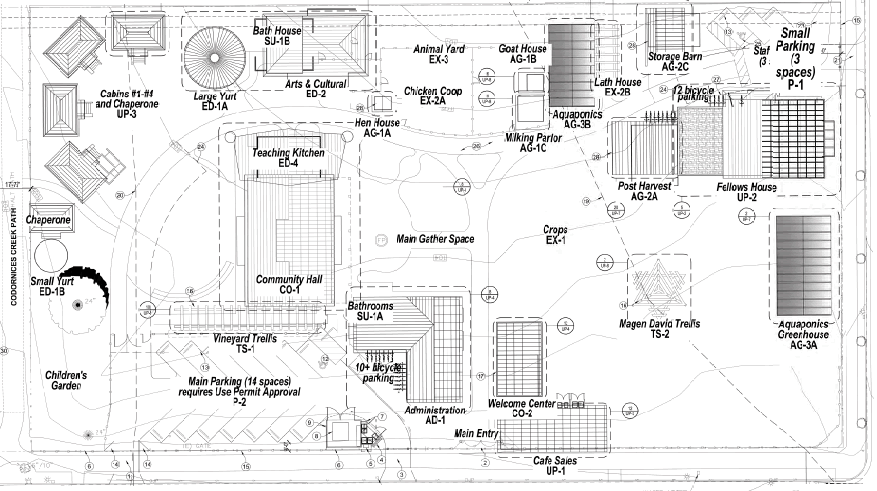Urban Adamah, the Berkeley-based educational farm and Jewish community center that has been working a one-acre site at 1050 Parker Street since 2010, and gives away over 10,000 pounds of freshly grown food each year, purchased a 2.2-acre site at 1151 Sixth Street in West Berkeley for $2.1 million in 2013 and has been working on plans to transition to the new site ever since.
Plans for around 12,600 square feet of classroom, farming, and administrative buildings to support a sustainable farm, education programs and vocational school on the new site have already been approved, as have the farm’s crops, orchard, herb garden, chickens and goats. And now, Urban Adamah is proposing to add a dormitory, urban campground and café to the mix as well.
The newly proposed additions and site plan:
1. A three-story, 6,500 square-foot Fellows’ and Apprentice’s dormitory for up to 16 people which would provided visiting interns and teachers with temporary lodging for up to 90 days.
2. An urban ‘campground’ with five cabins totaling approximately 2,000 square feet that would be used for short-term stays of up to five days for those participating in farm educational programs which would be held for up to 10 weeks each year.
3. A General Store which would house a farm stand and retail store selling produce and goods made on site as well as a café with on‐site consumption of food, beer and wine which would operate from 7:30 AM to 10:00 PM daily.
The new plans also include solar panels atop the larger building and would reduce the number of parking spaces from the required 29 to a proposed 17 and move the the majority of the parking to the corner of Sixth and Harrison.
When fully built out, Urban Adamah projects it will produce around 50,000 pounds of food which it will continue to distribute through food banks and a weekly free farm stand.
The revised plans for the project will be presented to the public this week in Berkeley on September 10.


This is nice for education and diversion. There is no economic reason for doing this though. Assume the 50,000 product worths at a premium of $4 per pound. The farm will yield $200,000 annually on a 2.2-acre of land. Subtract labor and material costs, property tax and possibly mortgage will leave it deep in red. The cafe is going to generate lot more revenue than the farm.
I guess for educational reasons, inefficiency can be tolerated. But I’m guessing the CO2 emissions per pound will be off the charts when compared to a real farm. It doesn’t take many trips to OSH or deliveries of small quantities of seeds or soil to completely kill the numbers for a farm.
agree. this “farm” will be an environmental disaster
I’m not sure it’s a disaster, but it’s certainly one of the less environmentally friendly uses of the land.
We all have our little crusades and mine is hating on the locally grown organic movement. Factory farming operates on low single digit margins at every step of the supply chain. So they care about every carbon molecule and every piece of fruit. Seriously, there’s a ton of money being made in early detection of food spoilage and finding farm equipment that’s not performing properly.
When farmers can make 100% markup on their products, suddenly, they don’t have to be anywhere near as efficient. Most likely the carbon footprint of a grape from Chile is less than one grown in Napa, since one is shipped in a container and the other is shipped in a truck that was bought used from U-Haul with half a million miles on it.
I love going to the farmers markets in the city. But I freely admit it’s a small luxury for me, not something that’s going to save the planet.
what is even weirder (and semi-contradictory, but only semi-) are farmers’ markets in fringe counties that still have extant “real” farms. Are you telling me that bland industrial grade strawberries shipped up from Rodriguez Farms in Watsonville are somehow superior to the local Hmong strawberry shacks which make a living on leftover pieces of land? I doubt it.
Urban farms confuse me. I grew up in rural Pennsylvania and moved to the big city to get away from farms. I’m sure that the economics of this farm are a joke and we’d be better off buying people food from Costco. So I guess it’s primarily a “farm museum” of sorts, where urban children can go, instead of seeing a real farm.
I just hope no one lives downwind of the Animal yard. That would be justified NIMBYism.
I agree with you in principal that farms belong in the country and not in the cities and people are misguided but your post above this one regarding your little crusade is dubious in its main claim and ignores a lot else wrong with industrial scale farming
Oh, there’s lots wrong there too, especially labor abuses. But most big changes come at the industrial scale. There are lots of people who think their hobby is going to change the world, whether it be biking or urban farming or cooking at home, or massage therapy, or whatever. What will change the world is the ending of farm subsidies in rich nations, charging for methane emissions, raising the cost of carbon (global cap and trade with sanctions on nations that don’t join), etc. But none of these involve fun hobby activities so “activists” don’t care.
I suppose that’s what my crusade is about, the idea that grass roots hobbyist policy matters.
The fallacy here, though, is that it is often the grass roots hobbyists that bring up the issues and generate movements for change. The big boys jump on board, but rarely do large corporations initiate things.
Totally apart from the economics, the produce at Costco usually tastes terrible. I’ve had some bad purchases at farmers’ markets too, but Costco just seems downright dependably bad. I’m just glad there is a diversity of suppliers between all the different types of markets out there.
Moved to get away from farms. Obviously nothing needs to be changed with industrial farming practices.
Typical Berkeley nonsense.
Fine by me.
Unless, of course, this is taking my tax dollars to sustain, in which case, here’s my middle finger.
On the scale of things your tax dollars are taken to sustain, this is minutely trivial.
How much money is the United States spending per day to help eviscerate Yemen at the behest of our bestest friends in the world, the Wahabbi-luvin’ Saudi monarchy?
It’s just the principle.
But, if you want to inflate the discussion up to larger issues, what about that sun of ours that will turn into a Red Giant in 5 billion years and expand out to engulf the Earth, turning our planet into a cinder? Huh?
Yes because 5 years and 5 billion years are so close they might as well be the same.
Counting the adjacent on-street spots, this urban farm sports about 20 parking spots per acre. That alone indicates that this enterprise doesn’t have a chance to serve as a real farm. The only justification is for leisure and education. Which is just fine. Just cut out the language touting its “impressive” productivity.
They should probably farm and sell marijuana to make some profit and teach something.
Do Coca plants grow at sea level?
Why not? Something different than the usual bland condos. Kudos to Berkeley!
You know, I’m sure all of this commenting is pretty fulfilling, but you could also…. Actually go there. In real life! And you could pet a goat, look at some kale, or talk to a human, and I’m sure the people that farm there could tell you a lot about what they do. Or you could do none of that. That’s cool too.
Commenting is life!
So do burritos grow on vines, in trees, or as row crops?
Burritos are tubers, silly! I’m planting a row of Carne Asada Jumbos next spring.
Glad to see they got the permits to make their vision continue! Some of the kindest people I’ve ever met work there.
An urban ‘campground’ . Isn’t that redundant to Telegraph Avenue? 🙂